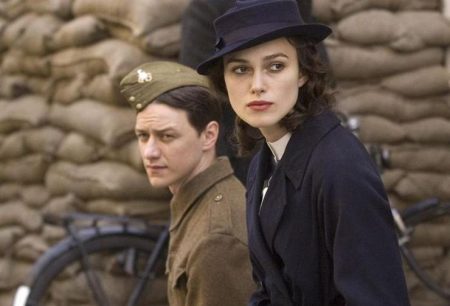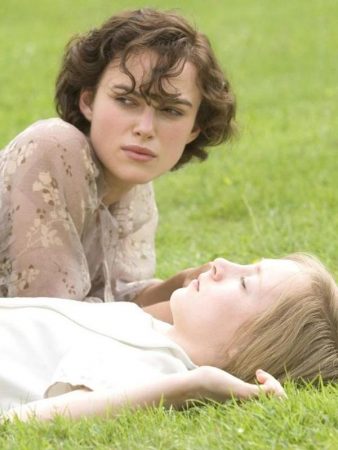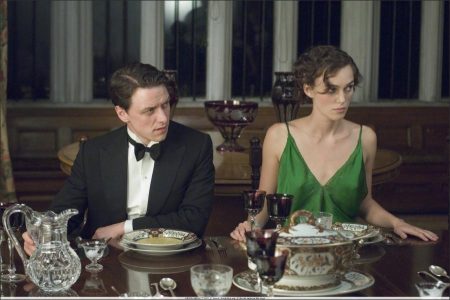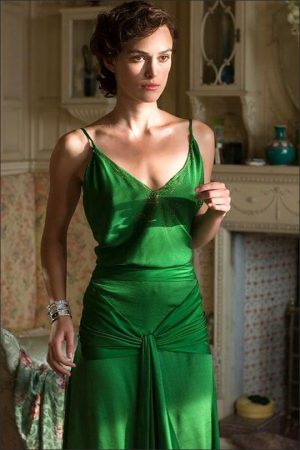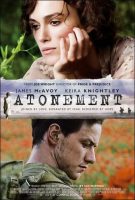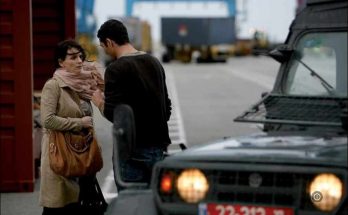Atonement Movie Trailer. Even as Pride & Prejudice was still playing around the world, Joe Wright and the trio of producers were asking members of the team to ready for the new movie together. Executive producers Debra Hayward and Liza Chasin, and co-producer Jane Frazer, would again be on board.
More valued key collaborators encored; production designer Sarah Greenwood, costume designer Jacqueline Durran, composer Dario Marianelli – all of whom had earned Academy Award nominations for their work on Pride & Prejudice – and editor Paul Tothill. Cinematographer Seamus McGarvey and hair and makeup designer Ivana Primorac, who had themselves worked together on The Hours, newly rounded out Wright’s team.
Greenwood affirms, “Joe likes to run a film like a repertory company, using the same team. It’s a very creative way of working, and you can hit the ground running because there’s a shorthand.”
Paul Webster adds, “There’s also a trust and a strength that are gained from a director having a team back together. The ideas and information flow.” Wright meticulously prepared for production, actively engaging with every department early on to communicate his vision, in order that the “book that happened in his head” could be dramatized on-screen and that once filming began, everyone was on the same page of that book.
“He’s the most prepared director I’ve ever worked with,” states Webster. “Once he has the film in his head, he designs it shot by shot and scene by scene with the cinematographer. He plots out every location. Then, he shares all this information with everyone, which is – in my experience – unique for a director.
“Before shooting begins, we are given a plan of the film, with everything down on paper; shot diagrams, storyboards, pictures. On those occasions when it changes during production, everyone gets the updates. What’s especially exciting is that the camera becomes the writer.”
“Joe has a strong vision,” offers Durran. “He will be quite specific about the look he wants, but he will also be open to your suggestions.”
The director conducted a three-week rehearsal period with the cast, ensuring that by the time the cameras rolled all the actors were comfortable with their characters and the environment(s) they inhabited. This afforded several members of the cast the chance to confer with fellow actors who were in different periods of the story.
Vanessa Redgrave says, “Saoirse Ronan and Romola Garai and I did some improvisations on body language, among other things, for Briony. Joe – who is brilliant with actors – was able to pick and choose what he wanted focused on during the filming.”
Wright adds, “We had meals together and talked to each other so that everyone would be able to express their emotions, including when we began filming. This way, there was no tension blocking communication.”
James McAvoy reveals, “We also learned dances like the foxtrot. Now, there’s not much dancing in the film, but spending an hour every day for three weeks doing this made the cast bond.”
Research was actively encouraged; Keira Knightley’s extensive reading about WWII in the U.K. so fascinated her that she continued exploring those years even after production had wrapped. Actors met with real-life WWII nurses and war veterans, including soldiers who had been at the Battle of Dunkirk.
The three parts of the film were envisioned with very different identities and looks which Wright wanted to subtly convey to the audience through the camera work and different color palettes. This necessitated complete correlation between the director and his heads of departments – McGarvey, Greenwood, Durran, and Primorac in particular. Wright would communicate what he needed and wanted to the department heads, and the departments in turn would unify and enhance each other’s work with a shared sensibility.
The department heads worked with a historian and then went on to research and prepare for each part/period; they looked at paintings, photographs, and films, and searched archives for inspiration to fit the story. This was especially important with regard to the WWII era being re-created.
Given the director’s preference for location shooting, Greenwood joined location manager Adam Richards (also encoring from Pride & Prejudice) in spending months scouring the U.K. for locales that could stand in for the French countryside and the French port of Dunkirk.
Webster notes, “The luxury and beauty of 1935 is fully conveyed; so, too is war and loss during 1939 and 1940.”
Primorac crafted hair and make-up that would subtly convey each period as well as how the characters’ circumstances and experiences are affecting them through the years. She notes, “The 1935 segment at the Tallis house has a stylized 1930s look, one heightened to a level that the British aristocracy would not have practiced at that time; we have made their world more glamorous than it even was. There’s something of a dreamlike quality, as in Briony’s memories of happier times.
Marianelli was not on the set like the other department heads, yet in a way he was; Wright’s preparation had extended to having the composer prepare a score for the first day of shooting. The music, shared with the cast and crew, helped to set the tone for the shoot as a whole; other scenes were also shot to pieces of the score that the composer had readied.
Filming of the film’s three sections was done almost entirely in sequence. The first part of Atonement is set on the hottest day of 1935, at the Tallis family home in Surrey, where the heat seems to affect the behavior of the individuals staying at or visiting the house.
Keira Knightley says, “As the day progresses, you sense unease in the air. In the heat, everything is languid. The people at the house are speaking very fast, yet they can’t quite move the way they want to.”
Wright notes, “The story reveals itself in layers in this section, and it was a wonderful journey for all of us while we were shooting this portion.”
Set decorator Katie Spencer, who had been Academy Award-nominated in tandem with Greenwood for Pride & Prejudice, rejoined her in searching for the house that would best embody the one described in McEwan’s book. The duo visited the archives of the U.K. magazine Country Life in the hope that they would come across properties which could be used to film the interior and/or the exterior scenes at the Tallis home on the fateful day and night. Stokesay Court, in Shropshire, had been featured in the magazine and was deemed perfect for both interiors and exteriors.
The script was modified to take into account the realities of the location once it had been set – “a fantastic way of working,” enthuses Greenwood. Then, it took seven weeks of preparation to ready Stokesay for five weeks of filming. For the crucial sequence in which Cecilia and Robbie orbit each other as well as a fountain in the garden, Greenwood’s team built a fountain over and around the existing Stokesay pond. This afforded a protective measure for the intact original structure, as well as creating a setting that even more strongly complement the actors’ performances.
Knightley muses, “Stokesay was such a gift because it is a private home, so it was all ours; on Pride & Prejudice, we had beautiful locations where we would be doing intimate scenes –while tour groups were there taking pictures…
“Joe brought us in a day ahead of the shoot, so we could spend time in our bedrooms and walk around the grounds. To be able to do all the interiors there as well was extraordinary.”
McAvoy concurs, noting, “We stayed there for the whole shoot. There wasn’t a couple of minutes’ drive to the set each morning; it was a couple of minutes’ walk. Joe knew we would get a sense of ownership, in addition to a sense of space and place. I think that familiarity comes across on-screen.”
Greenwood adds, “We shot at Stokesay during the summer. It was very lush there, and luckily they’d had a lot of rain so there was a very verdant quality to the grounds. Even luckier, it really was very hot during shooting!”
Webster notes, “Sarah and Katie really got into the detail of the story, and paid special attention to what was going on in design in the 1930s. In the first part, everything is ripe to the point of corruption, and they have used the patterns of chintz – which are quite popular today as well. The wallpapers and fabrics and Jacqueline’s costumes were all crucial to getting across this very dense and rich pattern-upon-pattern ideal.”
Greenwood reveals, “The main difference between Jacqueline’s costumes and the patterns that my department was using is that her colors are more vibrant than ours; ours were held back, so you have a separation that gives that much greater a contrast between what you see in Surrey and what you see subsequently in London and Dunkirk. The environments are at opposite extremes, so there has to be a juxtaposition of imagery.”
Mc Garvey worked closely with Wright on how the different parts of the film would look. The director says, “Seamus and I used the camera not only to capture the story visually but also as a storytelling device in itself, through the movement and techniques applied.”
“At the start of the film, there is dynamism with the camera,” notes McGarvey. “There’s a rhythm; Briony is restless and full of creative energy, so it’s as if she is pulling the camera all over the house and the grounds. Joe didn’t want to luxuriate in the period too much; certainly, everything is beautiful, but all the departments also concentrated on making everything look and feel vital to the story.
“The lustrous quality of the 1935 scenes was achieved by using particular filters – and, older Christian Dior stockings! – over the lens, which created a beautiful glow. There’s a lot of blue in the first part. When things take a darker turn in the first portion, we continue to use the filters, but that sweetness becomes more saccharine. There is a darkness that keeps surfacing, and which is progressed and built upon in the other parts of Atonement.”
Durran adds, “Joe and I talked about how that summer day is the last perfect moment, before the fall – in both senses of that word.
“With Cecilia in the first part, the idea was that everything she wear be light and transparent, almost like a butterfly. For the backless evening dress, Joe wanted something that would flow because Keira would have to run in it. So we created a fuller skirt and narrower hips, and we picked this specific shade of green. Keira was involved in the process, so it really was a collaboration.”
Knightley enthuses, “Jacqueline and her team made such beautiful clothes for me to wear as Cecilia in the 1935 scenes. They did an absolutely incredible job!”
Primorac says, “Keira has less vanity than anyone I’ve ever met. When we were working guidelines out for Cecilia in 1935 – how stiff the waves in her hair would be, for example – Keira was ready for whatever was right for our story.
“When the war starts, we had to convey how Cecilia doesn’t have as many resources; she still does her hair, though not as often. The temptation was to go outright from glamorous in the first section to dowdy in the second section. But that’s not Cecilia; she would still put on lipstick if she could get one, or had one left over.”
In the three parts, three different actresses progressively incarnate Briony Tallis. But a distinct look for the character, and the actresses, had to be maintained through hair and make-up as well as costuming.
Durran elaborates, “This meant keeping the color palate similar; so, because we start off in the first part with Saoirse in blue and off-white, we carry that on to the pale blue-and-white of Romola’s nurse’s uniform. These colors remain consistent for when you see Vanessa in the third part, wearing a dress that has elements of the dress that Saoirse wears in the first part.
“What I aim for, most of all, is that the costumes contribute to the actors’ performances and adds something for them and Joe to work with.”
Primorac and her department paid special attention to everything to the three Brionys. She notes, “We tried to make the lips into similar shapes, and matched their eyelashes and cheekbones. Giving them the same texture of hair tells you, ‘This is Briony.’ I think we succeeded because of the skill of these actresses, with Saoirse setting the tone.
“The London section was quite complicated because of Briony’s working in the hospital, and the wounds that she tends to. But Joe’s process is so detailed, and he has researched everything himself, so we knew what was called for.”
Also for the second part, McGarvey and Wright adapted the camera technique to convey the change from the rich hues of the Tallis house to grittier wartime London and France. The cinematographer says, “The Dunkirk sequences are more symmetrical; with the homefront in London – and the war hitting home – we adopt a more handheld and jagged approach to the cinematography. That applied to the light as well, which becomes harder and more brittle and abrupt; there’s more contrast in the visuals.”
Only eight U.K. military ambulances from WWII remain, and Atonement made use of them all. Uniforms from WWII were also used, but Durran had to have the majority made, given how many extras would be in the scenes. She notes, “We sourced original webbing, original helmets, and original hobnail boots, among other elements.”
All of the nurses’ uniforms had to be created, again with originals as reference points. Durran clarifies, “With the blue-and-white stripes, we did effect a change from the original lilac-and-white; we also modified what is worn in once scene, for dramatic purposes. All else, we got as right as we could, down to the Nightingale badges being reproduced for those qualifying nurses; you see Cecilia still wearing one, but by that point in the story she has moved on to another hospital.”
When WWII sends Robbie and his British Expeditionary Force (BEF) unit through France, the full scale – human and spatial – of the army’s retreat from and at Dunkirk is captured in a single shot worked out by Wright and McGarvey with steadicam operator Peter Robertson.
Wright says, “The sequence was originally scripted as a montage. But that would have required 30-40 set-ups in a single day, with consistent light. So we went a different route.”
McGarvey adds, “We wanted something that would evolve within the scene itself, and was appropriate for the context. The conventional way to shoot what Robbie is seeing would be to go for a wide shot with a longer lens. With this shot, you are with Robbie, so you share his point of view and also see his face, his reaction to it all.”
The sequence was filmed on location at the seaside town of Redcar, with its existing beach and Corus Steelworks industrial landscape; 1,000 locals were employed to portray wounded or dying U.K. soldiers stranded on the beach at Dunkirk while awaiting safe passage home in 1940.
Greenwood notes, “Joe wanted the scale to be fully conveyed. To me, this shot says everything about Dunkirk – and about Robbie’s journey.”
Ian McEwan reveals, “My father was in or attached to the British army for 50 years. He was on the beach at Dunkirk, severely wounded and then evacuated. When he talked about it, you could see the darkness of the memory, yet also the sense that it was when he felt most fully alive.”
McAvoy reflects, “We talked to one veteran who couldn’t tell us a lot. He said, ‘When you’re doing it, boys, just think about how bad it really was.’ It was hard for him to even say that to us.”
All departments worked together to marshal for the sequence – among many other elements – a bandstand, French and British army weapons both vintage and re-created, a working ferris wheel, bombed-out buildings, a huge beached Thames barge, a choir in performance, and show horses.
In the five-and-one-half minute uninterrupted shot, the camera follows James McAvoy, Daniel Mays, and Nonso Anozie – as Robbie and the two other surviving British soldiers from his decimated unit – as they tenaciously search for any quieter space to try to decompress in.
Webster says, “James’ powers of concentration and transformation impressed me all through the shoot. When it came time to shoot this sequence, he was moving through it all and reacting – which, in a way, is the hardest kind of acting. Robbie witnesses a lot, and James conveys his inner state brilliantly.”
Tim Bevan comments, “In all of our movies, we’ve only ever done one sequence even close to this; this is epic, and spectacular – but the spectacle is there to emphasize the very emotional feeling of the sequence, of how it was for these young men nearly 70 years ago.
“The shot is also an example of the magic of cinema when you have something epic like this, you catch it on film, and then it’s gone – in terms of the set and the moment. Then it lives forever in the movie.”
McGarvey elaborates, “It was what filmmaking is all about – collaboration. Bear in mind that in addition to the 1,000 extras, there were 300 crew members at work – all without a weak link in the people chain.”
Wright remembers, “It was very, very exciting and I loved doing it. We spent all day rehearsing it, from 6 AM to 6: 30 PM. The next day, we did one more rehearsal and then shot three takes. It became like a piece of theatre. The light was amazing; I had faith that it would be. We were all was so engaged and involved; everybody realized what we were trying to achieve.”
Throughout post-production as well, departments worked in harmony, with special regard to the sound and editing processes. From the enhanced sound effect of rushing water when Cecilia emerges from the Tallis estate’s fountain to the clipped upper-class accents of the Tallis family to the interweaving of the sound of typewriter keys into Dario Marianelli’s score, every detail was worked out and unified.
Wright notes, “Our editor Paul Tothill is a master of sound, and we built up the sound as we edited. We wanted to make the picture and the soundtrack into an integrated, cohesive whole. Dario would give us so much to work with.”
For scoring, Marianelli reconvened key Pride & Prejudice collaborators, including – to perform the score he composed – the English Chamber Orchestra.
“Atonement is a cinematic symphony,” assesses Redgrave. “In cinema terms, it’s a real film – and a heartrending one.”
Christopher Hampton says, “Joe has a strong grasp of what’s doable in the editing room with Paul. The finished film moves like an express train.”
Wright says, “The nine-month post-production process was delicate; we had to be sensitive to what the material was telling us. All the way through, our producers made me more confident on Atonement than even on Pride & Prejudice.”
Bevan comments, “Joe is still hungry; he’s always the one to leap from the front, be up earlier and work later, and always striving for a greater quality.”
Paul Webster adds, “He’s a great romantic who communicates philosophical themes and ideas in cinematic form so that they are comprehensible to the filmgoer. Like all good artists, he explores stories that reflects himself and his view of the world.”
Wright concludes, “I’m honored to have had the chance to make this film, and to have worked with the people I did on it.
“Atonement is so close to me that I cannot look at it objectively; but, other people’s work, I can look at objectively – and I am incredibly proud of what our cast and crew achieved.”
The Locations
As with Pride & Prejudice, Atonement was made by the filmmaking team on locations all over Britain. Some of the specific shooting sites were; Stokesay Court, Shropshire Stokesay Court is a Victorian house (built in 1889) which forms part of the privately owned Stokesay estate in the county of Shropshire. All the exteriors and interiors of the Tallis home and the Turner cottage were filmed at Stokesay.
London
London locations included Whitehall and Bethnal Green Town Hall. The latter was used for the scene where Cecilia and Robbie are reunited in 1939 at a tea house.
The underground Balham station scene set in 1940 was filmed at the closed tube (a.k.a. subway) station Aldwych.
A street in the Streatham neighborhood was dressed for the scene set in Balham when Briony, at age 18, is looking for where Cecilia is living.
The St. Thomas’s hospital ward interior and corridors were built as a studio set at Shepperton Studios. However, the hospital’s storeroom, day room, and nurses’ dormitory scenes were filmed at Park Place, Henley Upon Thames; the exterior of the hospital was actually University College.
The wedding scene was filmed at St. John’s Church, Smith Square.
The third portion of Atonement was filmed at the BBC Studios in Wood Lane.
Dunkirk and the French countryside
The scenes with Robbie and his fellow soldiers making their way through the French countryside en route to Dunkirk were filmed in Coates and Gedney Drove End, in Lincolnshire; in Walpole St. Andrew and Denver, in Norfolk; and in March and Pymore, in Cambridgeshire.
The poppy field scene was shot in Cheltenham, Gloucestershire.
The light industrial quarter scenes were filmed at the Grimsby fish docks; the heavy industrial quarter, as well as the marshland, scenes were filmed at Corus Steelworks, in Redcar. The latter’s beach was the site of the Dunkirk beach sequence, and also stood in for the Bray dunes.
The French cinema at Dunkirk that Robbie drifts through was in fact Redcar’s venerable Regent Cinema, which is located on the pier at the beach.
Atonement (2007)
Directed by: Joe Wright
Starring: Keira Knightley, James McAvoy, Romola Garai, Brenda Blethyn, Vanessa Redgrave, Anthony Minghella, Harriet Walter, Juno Temple, Felix von Simson, Patrick Kennedy, Peter Wight
Screenplay by: Christopher Hampton
Production Design by: Sarah Greenwood
Cinematography by: Seamus McGarvey
Film Editing by: Paul Tothill
Costume Design by: Jacqueline Durran
Music by: Dario Marianelli
MPAA Rating: R for disturbing war images, language and some sexuality.
Distributed by: Working Title Films, Focus Features
Release Date: December 7, 2007
Views: 169
